3Com 4060, 4050 User Manual

3Com® Switch 4050 and 4060
Getting Started Guide
3C17708, 3C17709
http://www.3com.com/
Part No. DUA1770-9AAA03
Published September 2002
3Com Corporation 5400 Bayfront Plaza Santa Clara, California 95052-8145
Copyright © 2002, 3Com Technologies. All rights reserved. No part of this documentation may be reproduced in any form or by any means or used to make any derivative work (such as translation, transformation, or adaptation) without written permission from 3Com Technologies.
3Com Technologies reserves the right to revise this documentation and to make changes in content from time to time without obligation on the part of 3Com Technologies to provide notification of such revision or change.
3Com Technologies provides this documentation without warranty, term, or condition of any kind, either implied or expressed, including, but not limited to, the implied warranties, terms or conditions of merchantability, satisfactory quality, and fitness for a particular purpose. 3Com may make improvements or changes in the product(s) and/or the program(s) described in this documentation at any time.
If there is any software on removable media described in this documentation, it is furnished under a license agreement included with the product as a separate document, in the hard copy documentation, or on the removable media in a directory file named LICENSE.TXT or !LICENSE.TXT. If you are unable to locate a copy, please contact 3Com and a copy will be provided to you.
UNITED STATES GOVERNMENT LEGEND
If you are a United States government agency, then this documentation and the software described herein are provided to you subject to the following:
All technical data and computer software are commercial in nature and developed solely at private expense. Software is delivered as “Commercial Computer Software” as defined in DFARS 252.227-7014 (June 1995) or as a “commercial item” as defined in FAR 2.101(a) and as such is provided with only such rights as are provided in 3Com’s standard commercial license for the Software. Technical data is provided with limited rights only as provided in DFAR 252.227-7015 (Nov 1995) or FAR 52.227-14 (June 1987), whichever is applicable. You agree not to remove or deface any portion of any legend provided on any licensed program or documentation contained in, or delivered to you in conjunction with, this User Guide.
Unless otherwise indicated, 3Com registered trademarks are registered in the United States and may or may not be registered in other countries.
3Com and the 3Com logo are registered trademarks of 3Com Corporation.
IEEE and 802 are registered trademarks of the Institute of Electrical and Electronics Engineers, Inc.
Intel and Pentium are registered trademarks of Intel Corporation. Microsoft, MS-DOS, Windows, and Windows NT are registered trademarks of Microsoft Corporation. Novell and NetWare are registered trademarks of Novell, Inc. UNIX is a registered trademark in the United States and other countries, licensed exclusively through X/Open Company, Ltd.
Netscape Navigator is a registered trademark of Netscape Communications.
JavaScript is a trademark of Sun Microsystems.
All other company and product names may be trademarks of the respective companies with which they are associated.
ENVIRONMENTAL STATEMENT
It is the policy of 3Com Corporation to be environmentally-friendly in all operations. To uphold our policy, we are committed to:
Establishing environmental performance standards that comply with national legislation and regulations.
Conserving energy, materials and natural resources in all operations.
Reducing the waste generated by all operations. Ensuring that all waste conforms to recognized environmental standards. Maximizing the recyclable and reusable content of all products.
Ensuring that all products can be recycled, reused and disposed of safely.
Ensuring that all products are labelled according to recognized environmental standards.
Improving our environmental record on a continual basis.
End of Life Statement
3Com processes allow for the recovery, reclamation and safe disposal of all end-of-life electronic components.
Regulated Materials Statement
3Com products do not contain any hazardous or ozone-depleting material.
Environmental Statement about the Documentation
The documentation for this product is printed on paper that comes from sustainable, managed forests; it is fully biodegradable and recyclable, and is completely chlorine-free. The varnish is environmentally-friendly, and the inks are vegetable-based with a low heavy-metal content.
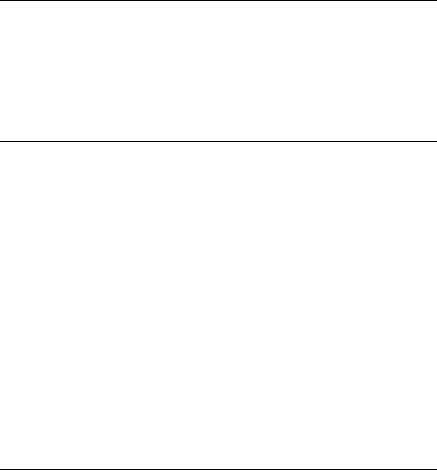
CONTENTS
ABOUT THIS GUIDE
Conventions 8
Related Documentation 9
Accessing Online Documentation 9
Product Registration 10
Documentation Comments 10
1INTRODUCING THE
3COM SWITCH 4050 AND 4060
About the 3Com Switch 4050 and 4060 |
12 |
|
||
Summary of Hardware Features 13 |
|
|
||
3Com Switch 4050 and 4060 — Front View Detail |
14 |
|||
1000BASE-SX Ports 15 |
|
|
||
10BASE-T/100BASE-TX/1000BASE-T Ports 15 |
|
|||
GBIC Ports |
15 |
|
|
|
Console Port |
15 |
|
|
|
LEDs 16 |
|
|
|
|
3Com Switch 4050 and 4060 — Rear View Detail |
18 |
|||
Expansion Module Slot |
18 |
|
|
|
Replaceable Power Supplies (PSUs) |
18 |
|
||
Power Socket |
19 |
|
|
|
Replaceable Fan Trays |
19 |
|
|
|
Default Settings |
20 |
|
|
|
2 INSTALLING THE SWITCH
Package Contents |
22 |
|
Choosing a Suitable Site 22 |
|
|
Rack-mounting |
23 |
|
Placing Units On Top of Each Other |
24 |
|
Creating an XRN Distributed Fabric |
24 |
|
How To Interconnect Units 25 |
|
|
|
Rules For Interconnecting Units |
25 |
|
|
|
|||
|
The Power-up Sequence |
26 |
|
|
|
|
|
|
|
Powering-up the 3Com Switch 4050 and 4060 |
26 |
||||||
|
Checking for Correct Operation of LEDs |
26 |
|
|||||
|
Choosing the Correct 10/100/1000 Cables 27 |
|
||||||
|
Choosing the correct Fiber cables |
28 |
|
|
||||
|
GBIC Operation 28 |
|
|
|
|
|
|
|
|
Approved GBIC Transceivers |
28 |
|
|
|
|
||
|
Inserting a GBIC Transceiver |
29 |
|
|
|
|||
|
|
|
|
|
||||
3 SETTING UP FOR MANAGEMENT |
|
|
|
|||||
|
Setting Up Overview 32 |
|
|
|
|
|
|
|
|
IP Configuration |
33 |
|
|
|
|
|
|
|
Preparing for Management |
34 |
|
|
|
|
||
|
Manually Configuring IP Information |
35 |
|
|
||||
|
Connecting to a Front Panel Port |
35 |
|
|
|
|||
|
Connecting to the Console Port |
38 |
|
|
|
|||
|
Viewing Automatically Configured IP Information |
41 |
||||||
|
Using 3Com Network Supervisor |
41 |
|
|
|
|||
|
Connecting to the Console Port |
42 |
|
|
|
|||
|
Methods of Managing a Switch |
44 |
|
|
|
|
||
|
Command Line Interface Management |
44 |
|
|||||
|
Web Interface Management |
45 |
|
|
|
|
||
|
SNMP Management |
45 |
|
|
|
|
|
|
|
Setting Up Command Line Interface Management |
46 |
||||||
|
CLI Management via the Console Port |
|
46 |
|
||||
|
CLI Management over the Network |
46 |
|
|||||
|
Setting Up Web Interface Management |
47 |
|
|||||
|
Pre-requisites |
47 |
|
|
|
|
|
|
|
Web Management Over the Network |
|
48 |
|
||||
|
Setting Up SNMP Management |
49 |
|
|
|
|
||
|
Pre-requisites |
49 |
|
|
|
|
|
|
|
Default Users and Passwords 49 |
|
|
|
|
|||
|
Changing Default Passwords |
50 |
|
|
|
|||
|
|
|
|
|
|
|
|
|
4 PROBLEM SOLVING |
|
|
|
|
|
|
||
|
Solving Problems Indicated by LEDs |
52 |
|
|
|
|||
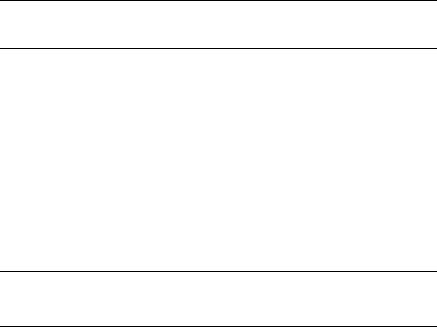
|
Solving Hardware Problems |
54 |
|
|
|
Solving Communication Problems |
58 |
||
|
Solving Software Upgrade Problems |
59 |
||
A |
|
|
|
|
SAFETY INFORMATION |
|
|
||
|
Important Safety Information |
62 |
|
|
|
L’information de Sécurité Importante |
65 |
||
|
Wichtige Sicherheitsinformationen |
68 |
||
B |
|
|
|
|
PIN-OUTS |
|
|
|
|
|
Null Modem Cable |
71 |
|
|
|
PC-AT Serial Cable |
71 |
|
|
|
Modem Cable 72 |
|
|
|
RJ-45 Pin Assignments 72
CTECHNICAL SPECIFICATIONS
DTECHNICAL SUPPORT
Online Technical Services |
77 |
|
|
World Wide Web Site |
77 |
|
|
3Com Knowledgebase Web Services |
77 |
||
3Com FTP Site |
78 |
|
|
Support from Your Network Supplier |
78 |
||
Support from 3Com |
79 |
|
|
Email Support |
79 |
|
|
Telephone Support |
79 |
|
|
Returning Products for Repair 81 |
|
||
INDEX
REGULATORY NOTICES

ABOUT THIS GUIDE
This guide provides all the information you need to install and use a 3Com® Switch 4050 and 4060 in its default state.
The guide is intended for use by network administrators who are responsible for installing and setting up network equipment; consequently, it assumes a basic working knowledge of LANs (Local Area Networks).
Please refer to the CD-ROM that accompanies your Switch for the following:
■Management Interface Reference Guide — an online guide which gives you detailed information on how to use the web interface and command line interface to manage the Switch.
■3Com Network Supervisor — a powerful network management tool for small to medium enterprise networks.
■A number of other useful applications.
■Other documentation relating to the Switch 4050 and 4060.
If the information in the release notes that are shipped with your product differ from the information in this guide, follow the instructions in the release notes.
Most user guides and release notes are available in Adobe Acrobat Reader Portable Document Format (PDF) or HTML on the 3Com World Wide Web site:
http://www.3com.com/
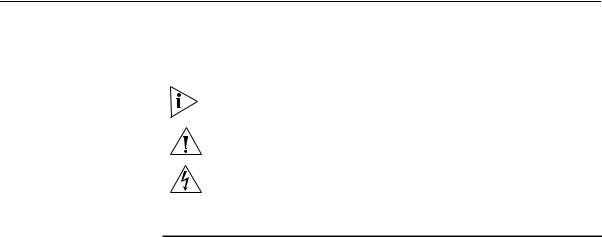
8 ABOUT THIS GUIDE
Conventions |
Table 1 and Table 2 list conventions that are used throughout this guide. |
||
|
Table 1 |
Notice Icons |
|
|
|
|
|
|
Icon |
Notice Type |
Description |
|
|
|
|
|
|
Information note |
Information that describes important features or |
|
|
|
instructions. |
|
|
Caution |
Information that alerts you to potential loss of data or |
|
|
|
potential damage to an application, system, or device. |
|
|
Warning |
Information that alerts you to potential personal |
|
|
|
injury. |
|
|
|
|
Table 2 Text Conventions
Convention |
Description |
Screen displays |
This typeface represents information as it appears on the |
|
screen. |
Syntax |
The word “syntax” means that you must evaluate the syntax |
|
provided and then supply the appropriate values for the |
|
placeholders that appear in angle brackets. Example: |
|
To change your password, use the following syntax: |
|
system password <password> |
|
In this example, you must supply a password for <password>. |
|
|
Commands |
The word “command” means that you must enter the |
|
command exactly as shown and then press Return or Enter. |
|
Commands appear in bold. Example: |
|
To display port information, enter the following command: |
|
bridge port detail |
The words “enter” |
When you see the word “enter” in this guide, you must type |
and “type” |
something, and then press Return or Enter. Do not press |
|
Return or Enter when an instruction simply says “type.” |
|
|
Keyboard key names |
If you must press two or more keys simultaneously, the key |
|
names are linked with a plus sign (+). Example: |
|
Press Ctrl+Alt+Del |
|
|
Words in italics |
Italics are used to: |
|
■ Emphasize a point. |
|
■ Denote a new term at the place where it is defined in the |
|
text. |
|
■ Identify menu names, menu commands, and software |
|
button names. Examples: |
|
From the Help menu, select Contents. |
|
Click OK. |
|
|

Related Documentation |
9 |
Related |
In addition to this guide, each Switch documentation set includes the |
|
Documentation |
following: |
|
|
■ Management Quick Reference Guide |
|
|
|
This guide contains: |
|
|
■ a list of software features supported by each Switch. |
|
|
■ a summary of the web interface and command line interface |
|
|
commands for the Switch. |
|
■ |
Release Notes |
|
|
These notes provide information about the current software release, |
|
|
including new features, modifications, and known problems. |
|
■ |
Switch Implementation Guide |
|
|
This guide contains information on the features supported by your |
Switch and how they can be used to optimize your network. It is supplied in PDF format on the CD-ROM that accompanies the Switch.
■ Management Interface Reference Guide
This guide provides detailed information about the web interface and command line interface that enable you to manage the Switch. It is supplied in HTML format on the CD-ROM that accompanies the Switch.
There are other publications you may find useful:
■ Documentation accompanying the Expansion Modules.
■ Documentation accompanying 3Com Network Supervisor. This is supplied on the CD-ROM that accompanies the Switch.
Accessing Online The CD-ROM supplied with your Switch contains the following online Documentation documentation:
■Switch Implementation Guide (PDF format).
■Switch Management Interface Reference Guide (HTML format).
■Other documentation relating to the Switch 4050 and 4060 (PDF format).
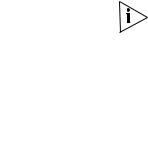
10 ABOUT THIS GUIDE
To access the online documentation from the CD-ROM:
1Insert the CD-ROM into the relevant CD-ROM drive. If your PC has auto-run enabled, a splash screen will be displayed automatically.
2Select the Documentation section from the contents page.
If the online documentation is to be accessed from a local drive or server, you will need to access the CD-ROM contents via the root directory and copy the files from the CD-ROM to a suitable directory.
■The HTML Reference Guide is stored in the Docs/referenceguide on the CD-ROM. The documentation is accessed using the index.htm file.
■The PDF Implementation Guide is stored in the Docs/implementation directory of the CD-ROM.
|
3Com recommends that you copy the Docs/referenceguide |
|
directory as a whole to maintain the structure of the files. |
|
|
Product |
You can register your Switch on the 3Com Web site to receive up-to-date |
Registration |
information on your product: |
|
http://support.3com.com/registration/frontpg.pl |
|
|
Documentation |
Your suggestions are very important to us. They will help make our |
Comments |
documentation more useful to you. Please e-mail comments about this |
|
document to 3Com at: |
|
pddtechpubs_comments@3com.com |
|
Please include the following information when commenting: |
|
■ Document title |
|
■ Document part number (on the title page) |
|
■ Page number (if appropriate) |
|
Example: |
|
Part Number DUA1770-9AAA0x |
|
3Com Switch 4050 and 4060 Getting Started Guide |
|
Page 21 |
1 |
INTRODUCING THE |
3COM SWITCH 4050 AND 4060 |
This chapter contains introductory information about the 3Com® Switch 4050 and 4060 and how it can be used in your network. It covers summary information about the hardware and the following topics:
■About the 3Com Switch 4050 and 4060
■3Com Switch 4050 and 4060 — Front View Detail
■3Com Switch 4050 and 4060 — Rear View Detail
■Default Settings

12 CHAPTER 1: INTRODUCING THE 3COM SWITCH 4050 AND 4060
About the 3Com |
The 3Com Switch 4050 is a mixed media device which consists of: |
||
Switch 4050 and |
|
|
|
4060 |
■ |
12 10BASE-T/100BASE-TX/1000BASE-T ports |
|
|
■ |
6 |
1000BASE-SX ports |
|
■ 6 |
Gigabit Interface Convertor (GBIC) ports |
|
The 3Com Switch 4060 is a mixed media device which consists of:
■12 1000BASE-SX ports
■6 10BASE-T/100BASE-TX/1000BASE-T ports
■6 Gigabit Interface Convertor (GBIC) ports
You can also interconnect any combination of two Switches from the 3Com Switch 4050/4060 range or the SuperStack® 4900 Series to create an XRN Distributed Fabric. This allows you to create a highly resilient core around which you can build your network. For more information about interconnecting Switches, see “Creating an XRN Distributed Fabric” on page 24. For more information about 3Com XRN Technology and how to use it in your network, refer to the Implementation Guide on the CD-ROM that accompanies the Switch.
For information about using the software features of the Switch, refer to the “Switch Management Interface Reference Guide” on the CD-ROM that accompanies the Switch.

About the 3Com Switch 4050 and 4060 13
Summary of Table 3 summarizes the hardware features that are supported by the Hardware Features 3Com Switch 4050 and 4060.
Table 3 Hardware features
Feature |
3Com Switch 4050/4060 |
|
|
Addresses |
Up to 12,000 supported |
|
Up to 64 permanent entries |
Forwarding Modes |
Store and Forward |
Duplex Modes |
■ Half duplex only supported on |
|
10BASE-T/100BASE-TX/1000BASE-T Mbps ports in |
|
10/100 Mbps mode |
|
■ All 1000 Mbps ports are full duplex only |
Flow Control |
Supported on all ports |
Smart auto-sensing |
■ Supported on all 10BASE-T/100BASE-TX/1000BASE-T |
|
ports. |
|
■ Not supported on 1000BASE-SX and GBIC ports. |
Traffic Prioritization |
Supported (IEEE Std 802.1D, 1998 Edition) |
|
Four traffic queues per port |
Fast Ethernet and |
Auto-negotiating 10BASE-T/100BASE-TX/1000BASE-T, |
Gigabit Ethernet Ports |
1000BASE-SX and GBIC ports |
Mounting |
19-inch rack or stand-alone mounting |
Layer 3 Switching |
Support for wire-speed IP routing |
Replaceable PSUs |
Replaceable PSU and slot for optional second replaceable |
|
PSU |
Hot Swap Fans |
Two identical hot swap fan trays are fitted |
XRN Support |
eXpandable Resilient Networking (XRN) support. Allows |
|
interconnection of two units to create a Distributed |
|
Fabric. |
|
|
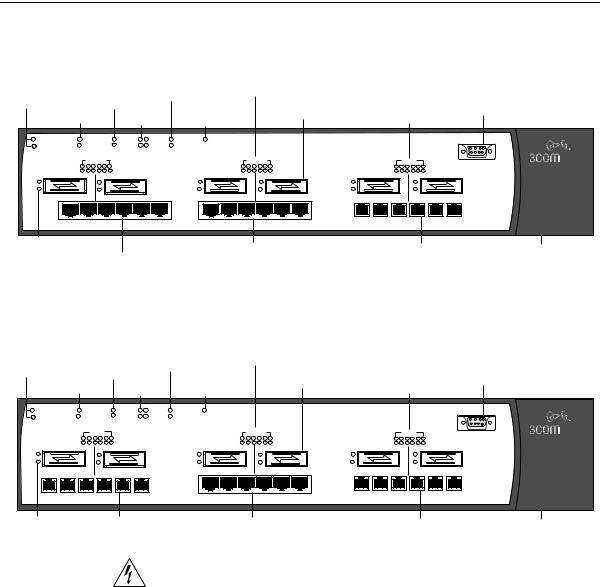
14 CHAPTER 1: INTRODUCING THE 3COM SWITCH 4050 AND 4060
3Com Switch 4050 |
Figure 1 3Com Switch 4050 — front view |
|
|||||
and 4060 — Front |
|
|
|
|
|
||
View Detail |
|
|
|
|
|
|
|
Unit Status LED |
Module |
10BASE-T/100BASE-TX/1000BASE-T LEDs |
|
||||
Status LEDs |
|
||||||
and Layer 3 LED |
|
|
|
|
|||
Fan LEDs |
Temperature |
GBIC Ports |
|
Console Port |
|||
PSU LEDs Unit LEDs |
1000BASE-SX LEDs |
||||||
|
LED |
|
|||||
|
|
|
|||||
UNIT STATUS |
1 |
|
|
|
|
|
F |
|
1 |
2 |
|
P |
TEMP |
P = Packet |
Yellow = 10/100Mbps |
Green = 1000Mbps |
On = enabled, link OK |
Flashing = disabled |
|
|
|
|
|
3Com Switch 4050 |
|
LAYER 3 |
2 |
PSU |
|
|
|
R |
FANS |
3 |
4 |
UNIT |
S |
MODULE |
S = Status |
|
|
|
|
|
|
|
|
|
|
|
|
|
|
|
|
|
|
|
|
|
|
|
|
|
|
|
|
|
|
|
|
|
|
|
|
|
|
|
|
|
10/100/1000 |
|
|
|
|
|
|
|
|
10/100/1000 |
|
|
|
|
|
1000SX |
|
|
|
||||
|
P |
13 |
14 |
15 |
16 |
17 |
18 |
|
|
|
|
|
|
P 13 |
14 15 16 17 18 |
|
|
P 19 |
20 |
21 |
22 |
23 |
24 |
|
|
|
S |
13 |
14 |
15 |
16 |
17 |
18 |
|
|
|
|
|
|
S 13 |
14 15 16 17 18 |
|
|
S |
19 |
20 |
21 |
22 |
23 |
24 |
|
GBIC 1 |
|
|
|
|
|
|
|
|
GBIC 2 |
|
|
GBIC 3 |
|
|
GBIC 4 |
|
GBIC 5 |
|
|
|
|
|
GBIC 6 |
|
|
P |
|
|
|
|
P |
|
|
|
|
|
|
|
P |
|
P |
|
|
P |
|
|
|
P |
|
|
|
S |
|
|
|
|
S |
|
|
|
|
|
|
|
S |
|
S |
|
|
S |
|
|
|
S |
|
|
|
|
|
|
|
|
|
|
|
|
|
|
|
|
|
|
|
|
|
|
|
|
|
|
|
3C17708 |
|
GBIC LEDs |
|
|
|
|
|
|
|
|
|
|
|
|
10BASE-T/100BASE-TX/1000BASE-T Ports |
1000BASE-SX Ports |
Front Fan Tray (behind door) |
||||||||||
|
|
|
|
|
|
|
|
|
|
|
|
|
|||||||||||||
10BASE-T/100BASE-TX/1000BASE-T Ports |
|
|
|
|
|
|
|
|
|
|
|
||||||||||||||
|
|
|
|
|
|
|
|
|
|
|
|
||||||||||||||
Figure 2 3Com Switch 4060 — front view
Unit Status LED |
|
Module |
10BASE-T/100BASE-TX/1000BASE-T LEDs |
|
||
|
Status LEDs |
|
||||
and Layer 3 LED |
|
|
|
|
|
|
Fan LEDs |
|
|
|
Console Port |
||
PSU LEDs |
Temperature |
GBIC Ports |
1000BASE-SX LEDs |
|||
Unit LEDs |
LED |
|
||||
|
|
|||||
UNIT STATUS |
1 |
|
|
|
|
|
F |
|
1 |
2 |
|
P |
|
TEMP |
P = Packet |
|
|
Yellow = 10/100Mbps |
Green = 1000Mbps |
On = enabled, link OK |
Flashing = disabled |
|
|
|
|
|
3Com Switch 4060 |
|||
LAYER 3 |
2 |
PSU |
|
|
|
|
R |
FANS |
3 |
4 |
UNIT |
S |
MODULE |
|
S = Status |
|
|
|
|
|
|
|
|
|
|
|
|
|
|
|
|
|
|
|
|
|
|
|
|
|
|
|
|
|
|
|
|
|
|
|
|
|
|
|
|
|
|
|
|
|
|
|
|
|
|
1000SX |
|
|
|
|
|
|
|
|
|
|
|
10/100/1000 |
|
|
|
|
|
|
1000SX |
|
|
|||||
|
P |
7 |
8 |
9 |
10 |
11 |
12 |
|
|
|
|
|
|
|
P |
13 |
14 |
15 |
16 |
17 |
18 |
|
|
P |
19 |
20 |
21 |
22 |
23 |
24 |
|
S |
7 |
8 |
9 |
10 |
11 |
12 |
|
|
|
|
|
|
|
S |
13 |
14 |
15 |
16 |
17 |
18 |
|
|
S |
19 |
20 |
21 |
22 |
23 |
24 |
GBIC 1 |
|
|
|
|
|
|
|
|
GBIC 2 |
|
|
|
GBIC 3 |
|
|
|
|
|
|
|
GBIC 4 |
|
GBIC 5 |
|
|
|
|
|
GBIC 6 |
|
P |
|
|
|
|
P |
|
|
|
|
|
|
|
|
P |
|
|
|
|
P |
|
|
|
|
P |
|
|
|
P |
|
|
S |
|
|
|
|
S |
|
|
|
|
|
|
|
|
S |
|
|
|
|
S |
|
|
|
|
S |
|
|
|
S |
|
|
|
|
|
|
|
|
|
|
|
|
|
|
|
|
|
|
|
|
|
|
|
|
|
|
|
|
|
|
|
|
3C17709 |
GBIC LEDs |
1000BASE-SX Ports 10BASE-T/100BASE-TX/1000BASE-T Ports |
1000BASE-SX Ports |
Front Fan Tray (behind door) |
WARNING: RJ-45 Ports. These are shielded RJ-45 data sockets. They cannot be used as standard traditional telephone sockets, or to connect the unit to a traditional PBX or public telephone network. Only connect RJ-45 data connectors, network telephony systems, or network telephones to these sockets.
Either shielded or unshielded data cables with shielded or unshielded jacks can be connected to these data sockets.

3Com Switch 4050 and 4060 — Front View Detail 15
1000BASE-SX Ports The auto-negotiating 1000BASE-SX ports have MT-RJ connectors.
The default state for these ports is auto-negotiation enabled, where the speed, duplex and flow control modes are negotiated. As the speed and duplex modes are fixed by the media type, only the flow control is negotiated with the link partner. Alternatively, auto-negotiation can be disabled and the flow control setting can be manually configured.
10BASE-T/ The 10BASE-T/100BASE-TX/1000BASE-T ports have RJ-45 connectors and 100BASE-TX/ are configured as Auto MDIX (cross-over).
1000BASE-T Ports
The default state for these ports is auto-negotiation enabled, where the speed, duplex and flow control modes of a link are automatically detected to provide the highest available bandwidth with the link partner.
Alternatively, auto-negotiation can be disabled. These ports can be manually configured to 10 Mbps half duplex, 100 Mbps half duplex, 10 Mbps full duplex or 100 Mbps full duplex. It is not possible to
manually configure a 1000 Mbps link as auto-negotiation is mandatory in the 1000 Mbps standard. If auto-negotiation is disabled, Auto MDIX cannot function and the ports are fixed as MDIX (cross-over) mode.
If auto-negotiation is disabled on a 1000 Mbps port, the speed will drop to the highest available speed. By default this is 100 Mbps.
GBIC Ports The 6 GBIC ports support fiber Gigabit Ethernet short-wave (SX), long-wave (LX) and long-haul (LH70) GBIC transceivers in any combination. This offers you the flexibility of using GBIC transceivers to provide connectivity between the Switch and remote 1000 Mbps workgroups or to create a high capacity aggregated link backbone connection.
The default state for these ports is auto-negotiation enabled, where the speed, duplex and flow control modes are negotiated. As the speed and duplex modes are fixed by the media type, only the flow control is negotiated with the link partner. Alternatively, auto-negotiation can be disabled and the flow control setting can be manually configured.
Console Port The console port allows you to connect a terminal and perform remote or local out-of-band management. The console port uses a standard null modem cable and is set to autobaud (up to a maximum of 19,200 baud), 8 data bits, no parity and 1 stop bit.
16 CHAPTER 1: INTRODUCING THE 3COM SWITCH 4050 AND 4060
LEDs Table 4 lists LEDs visible on the front of the Switch, and how to read their status according to color. For information on using the LEDs for problem solving, see “Checking for Correct Operation of LEDs” on page 26.
Table 4 |
LED behavior |
|
|
|
|
LED |
Color |
Indicates |
|
|
|
Port Status LEDs |
|
|
Packet |
Yellow |
Packets are being transmitted/received on the port. |
|
Off |
No packets are being transmitted/received on the port. |
Status |
Green |
A high speed (1000 Mbps) link is present, and the port |
|
|
is enabled. |
|
Green flashing |
A high speed (1000 Mbps) link is present, but the port |
|
|
is disabled. |
|
Yellow |
A low speed (10/100 Mbps) link is present, and the |
|
|
port is enabled. |
|
Yellow flashing |
A low speed (10/100 Mbps) link is present, but the port |
|
|
is disabled. |
|
Yellow flashing |
Port has failed self-test and has automatically been |
|
(fast) |
disabled. |
|
Off |
No link is present. |
Module Status LEDs |
|
|
|
Green |
The Module is installed and supported. The Link Status |
|
|
has been determined for a single port Module. |
|
Yellow |
The Module is installed and supported. The Module |
|
|
has multi-ports or there is no link for a single port |
|
|
Module. |
|
Yellow flashing |
The Module is installed but not supported. Note that |
|
|
the unit will continue to operate normally. |
|
Yellow flashing |
A port on the Module has failed POST and has been |
|
(fast) |
automatically disabled. |
|
Off |
The Module is not installed. |
Unit LEDs |
|
|
1–4 |
Green |
Determines the identity of the Switch when |
|
|
interconnected to another Switch to create a |
|
|
Distibuted Fabric. |
|
Off |
A fault has occurred. |
Unit Status LED |
|
|
|
Green |
The Switch is powered-up and operating normally. |

3Com Switch 4050 and 4060 — Front View Detail 17
LED |
Color |
Indicates |
|
|
|
Unit Status LED (cont.) |
|
|
|
Green flashing |
The Switch is either downloading software or is |
|
|
initializing (which includes running a Power On Self |
|
|
Test). |
|
Yellow |
The Switch has failed its Power On Self Test |
|
|
or |
|
|
A port has failed and had been automatically disabled. |
|
|
You can verify this by checking that the Port Status LED |
|
|
is quickly flashing Yellow. If a port fails the Switch |
|
|
passes its Power On Self Test and continues to operate |
|
|
normally. |
|
Off |
The Switch is not receiving power or there is a fault |
|
|
with the Power Supply unit. |
Layer 3 LED |
|
|
|
Green |
The Switch software supports Layer 3. |
|
Off |
The Switch software does not support Layer 3. |
PSU LEDs (Front of Switch)*
Green |
PSU fitted and enabled |
Red |
PSU fitted and not operational |
Red flashing |
PSU has shut down due to over-heating |
Off |
No PSU fitted |
PSU LED (PSU Module) |
|
Green |
The PSU module is installed and is supplying DC power |
|
to the Switch. |
Off |
The PSU module is not supplying power and may have |
|
shut down due to a fault. |
Fans (F = Front) |
|
Red |
One or both fans have failed |
Red flashing |
Fan Tray has been removed |
Off |
Fan Tray fitted and enabled. |
Fans (R = Rear) |
|
Red |
One or both fans have failed |
Red flashing |
Fan Tray has been removed |
Off |
Fan Tray fitted and enabled. |
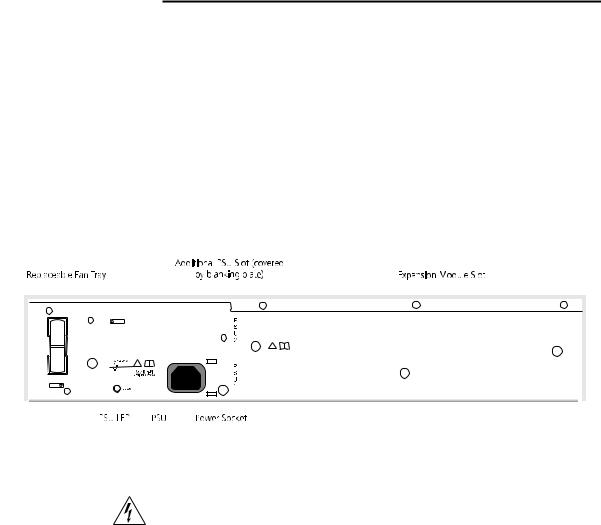
18 CHAPTER 1: INTRODUCING THE 3COM SWITCH 4050 AND 4060
LED |
Color |
Indicates |
|
|
|
Temperature |
|
|
|
Red flashing |
The Switch and/or the PSUs are above critical |
|
|
temperature and may shut down. |
|
Off |
The Switch and the PSUs are below critical |
|
|
temperature. |
|
|
|
|
|
|
|
|
|
|
|
|
|
|
|
|
|
* The PSU LEDs are visible on the front of the Switch and are marked ‘1’ for PSU 1 (bottom) and |
||||||||||||||||
|
|
|
|
|
|
|
|
|
|
|
|
|
|
‘2’ for PSU 2 (top). |
||||||||||||||||
|
|
|
|
|
|
|
|
|
|
|
|
|
|
|
|
|
|
|
|
|
|
|
|
|
|
|
|
|
|
|
3Com Switch 4050 |
Figure 3 3Com Switch 4050/4060 — rear view |
|||||||||||||||||||||||||||||
and 4060 — Rear |
|
|
|
|
|
|
|
|
|
|
|
|
|
|
|
|
|
|||||||||||||
View Detail |
|
|
|
|
|
|
|
|
|
|
|
|
|
|
|
|
|
|||||||||||||
|
|
|
|
|
|
|
|
|
|
|
|
|
|
|
|
|
|
|
|
|
|
|
|
|
|
|
|
|
|
|
|
|
|
|
|
|
|
|
|
|
|
|
|
|
|
|
|
|
|
|
|
|
|
|
|
|
|
|
|
|
|
|
|
|
|
|
|
|
|
|
|
|
|
|
|
|
|
|
|
|
|
|
|
|
|
|
|
|
|
|
|
|
|
|
|
|
|
|
|
|
|
|
|
|
|
|
|
|
|
|
|
|
|
|
|
|
|
|
|
|
|
|
|
|
|
|
|
|
|
|
|
|
|
|
|
|
|
|
|
|
|
|
|
|
|
|
|
|
|
|
|
|
|
|
|
|
|
|
|
|
|
|
|
|
|
|
|
|
|
|
|
|
|
|
|
|
|
|
|
|
|
|
|
|
|
|
|
|
|
|
|
|
|
|
|
|
|
|
|
|
|
|
|
|
|
|
|
|
|
|
|
|
|
|
|
|
|
|
|
|
|
|
|
|
|
|
|
|
|
|
|
|
|
|
|
|
|
|
|
|
|
|
|
|
|
|
|
|
|
|
|
|
|
|
|
|
|
|
|
|
|
|
|
|
|
|
|
|
|
|
|
|
|
|
|
|
|
|
|
|
|
|
|
|
|
|
|
|
|
|
|
|
|
|
|
|
|
|
|
|
|
|
|
|
|
|
|
|
|
|
|
|
|
|
|
|
|
|
|
|
|
|
|
|
|
|
|
|
|
|
|
|
|
|
|
|
|
|
|
|
|
|
|
|
|
|
|
|
|
|
|
|
|
|
|
|
|
|
|
|
|
|
|
|
|
|
|
|
|
|
|
|
|
|
|
|
|
|
|
|
|
|
|
|
|
|
|
|
|
|
|
|
|
|
|
|
|
|
|
|
|
|
|
|
|
|
|
|
|
|
|
|
|
|
|
|
|
|
|
|
|
|
|
|
|
|
|
|
|
|
|
|
|
|
|
|
|
|
|
|
|
|
|
|
|
|
|
|
|
|
|
|
|
|
|
|
|
|
|
|
|
|
|
|
|
|
|
|
|
|
|
|
|
|
|
|
|
|
|
|
|
|
|
|
|
|
|
|
|
|
|
|
|
|
|
|
|
|
|
|
|
|
|
|
|
|
|
|
|
|
|
|
|
|
|
|
|
|
|
|
|
|
|
|
|
|
|
|
|
|
|
|
|
|
|
|
|
|
|
|
|
|
|
|
|
|
|
|
|
|
|
|
|
|
|
|
|
|
|
|
|
|
|
|
|
|
|
|
|
|
|
|
|
|
|
|
|
|
|
|
|
|
|
|
|
|
|
|
|
|
|
|
|
|
|
|
|
|
|
|
|
|
|
|
|
|
|
|
|
|
|
|
|
|
|
|
|
|
|
Expansion Module You can use this slot to install an Expansion Module. Contact your Slot supplier for further information.
WARNING: When an Expansion Module is not installed, ensure the blanking plate is fitted by tightening all screws with a suitable tool.
Replaceable Power The 3Com Switch 4050 and 4060 has a bay for two internal power Supplies (PSUs) supplies. Contact your supplier for further information. For information
on installation and removal, please refer to the documentation that accompanies the replacement PSU.
The 3Com Switch 4050 and 4060 support the 3Com AC power supply unit (3C17718).

3Com Switch 4050 and 4060 — Rear View Detail 19
WARNING: The system must not be left without a power supply or a blanking plate in either of the two slots (except during replacement of the power supplies). Tighten all screws with a suitable screwdriver.
WARNING: Care must be taken when removing a PSU as it may be hot. The replacement of power supplies should be completed within two minutes to avoid normal cooling being disturbed.
Power Socket Each Power Supply automatically adjusts its power setting to any power voltage in the range 90-240 VAC.
WARNING: Mains power must be removed from the PSU before removing the PSU. A PSU must only be powered once it has been installed.
Replaceable Fan Trays The 3Com Switch 4050 and 4060 are provided with two identical fan trays which can be replaced. Contact your supplier for further information. For information on installation, please refer to the documentation that accompanies your fan tray.
The 3Com Switch 4050 and 4060 support the 3Com Fan Tray (3C17717).
WARNING: A fan tray can be temporarily removed and replaced while the system is running without impacting operations. The system must not be left with either fan tray removed for more than two minutes or damage to the product may be caused. Tighten all screws with a suitable screwdriver.
WARNING: Care must be taken when removing the fan tray as the fan blades may continue to spin for a short time after removal. Keep fingers clear.
CAUTION: You are advised to replace a failed fan as soon as possible. Although the unit will continue to operate after a single fan failure its airflow and temperature will be affected. In such circumstances, the unit may overheat and automatically shutdown. If the unit continues to operate with reduced airflow, its long term reliability will also be reduced.

20 CHAPTER 1: INTRODUCING THE 3COM SWITCH 4050 AND 4060
Default Settings Table 5 shows the default settings for the 3Com Switch 4050 and 4060. If you initialize one of the Switch units, it is returned to these defaults.
Table 5 Default Settings
Feature |
3Com Switch 4050/4060 |
|
|
Port Status |
Enabled |
Port Speed |
Auto-negotiated |
Duplex Mode |
Auto-negotiated |
Flow Control |
Auto-negotiated |
Broadcast Storm Control |
Enabled |
|
High threshold: 3000 broadcast frames per |
|
second — Notify and filter |
|
Low threshold: 1500 broadcast frames per |
|
second — Notify and unfilter |
Virtual LANs (VLANs) |
All ports belong to the untagged Default VLAN |
|
(VLAN 1) |
Multicast Filtering |
IGMP filtering enabled |
Rapid Spanning Tree Protocol |
Enabled |
Link Aggregation Control |
Enabled |
Protocol (LACP) |
|
Spanning Tree Protocol |
Enabled |
Smart Auto-sensing |
Enabled |
IP Address |
169.254.100.100* |
Subnet Mask |
255.255.0.0 |
*This default IP address is used if the unit is operating in standalone mode, and/or no other Switches on the network have this IP address. If this default IP address is already in use then the Switch detects this and configures itself with an IP address in the range 169.254.1.0 to 169.254.254.255.

2 |
INSTALLING THE SWITCH |
|
This chapter contains the information you need to install and set up the 3Com® Switch 4050 and 4060. It covers the following topics:
■Package Contents
■Choosing a Suitable Site
■Rack-mounting
■Placing Units On Top of Each Other
■The Power-up Sequence
■GBIC Operation
WARNING: Safety Information. Before installing or removing any components from the 3Com Switch 4050 and 4060 or carrying out any maintenance procedures, you must read the safety information provided in Appendix A of this guide.
AVERTISSEMENT: Consignes de sécurité. Avant d'installer ou d'enlever tout composant du 3Com Switch 4050 et 4060 ou d'entamer une procédure de maintenance, lisez les informations relatives à la sécurité qui se trouvent dans l'Appendice A de ce guide.
VORSICHT: Sicherheitsinformationen. Bevor Sie Komponenten aus dem 3Com Switch 4050 und 4060 entfernen oder dem 3Com Switch 4050 und 4060 hinzufuegen oder Instandhaltungsarbeiten verrichten, lesen Sie die Sicherheitsanweisungen, die in Anhang A in diesem Handbuch aufgefuehrt sind.
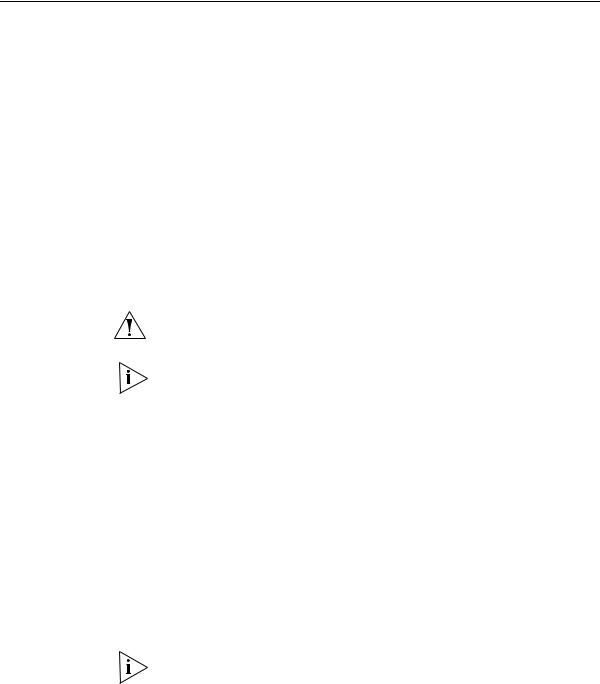
22 CHAPTER 2: INSTALLING THE SWITCH
Package Contents |
■ |
3Com Switch 4050 (3C17708) or Switch 4060 (3C17709) |
|
■ |
CD-ROM |
|
■ |
This Guide |
|
■ Management Quick Reference Guide |
|
|
■ |
Release Notes |
|
■ |
Warranty Flyer |
|
■ |
Power Cord |
|
■ 2 x securing brackets |
|
|
■ |
8 x screws |
|
■ 4 x rubber feet |
|
|
|
|
Choosing a Suitable |
The 3Com Switch 4050 and 4060 are suited for use in an internal wiring |
|
Site |
closet, a network room, or telecommunications room, where they can be |
|
mounted in a standard 19-inch equipment rack, or free-standing.
CAUTION: Ensure that the ventilation holes are not obstructed.
To ensure these products provide optimum performance, high speed fans are used to provide ventilation. These fans have a high audible output.
When deciding where to position the Switch, ensure that: ■ Cabling is located away from:
■ sources of electrical noise such as radios, transmitters and broadband amplifiers.
■ power lines and fluorescent lighting fixtures.
■ The Switch is accessible and cables can be connected easily.
■ Water or moisture cannot enter the case of the Switch.
■ Air flow is not restricted around the Switch or through the vents in the side of the Switch. 3Com recommends that you provide a minimum of 25 mm (1 in.) clearance.
■ Air temperature around the Switch does not exceed 40 °C (104 °F).
If the Switch is installed in a 19-inch rack or closed assembly its local air temperature may be greater than room ambient temperature.
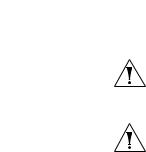
Rack-mounting 23
■ The air is as free from dust as possible.
■ The Switch is situated away from sources of conductive (electrical) dust, for example laser printers.
|
■ The unit is installed in a clean, air conditioned environment. |
|
■ The AC supply used by the Switch is separate to that used by units |
|
that generate high levels of AC noise, for example air conditioning |
|
units. |
|
■ No more than four Switch units are placed on top of one another, if |
|
the units are free-standing. |
|
|
Rack-mounting |
The Switch 4050 and 4060 are 2U high and will fit in most standard |
|
19-inch racks. |
|
CAUTION: Disconnect all cables from the Switch before continuing. |
|
Remove all self adhesive pads from the underside of the Switch if they |
|
have been fitted. |
|
CAUTION: If you use a shelf or support ensure that it will not obstruct |
|
the air flow through the side panels of the Switch. |
|
To rack-mount your Switch: |
|
1 Place the Switch the right way up on a hard flat surface, with the front |
|
facing towards you. |
|
2 Locate a securing bracket over the mounting holes on one side of the |
|
Switch, as shown in Figure 4. |
|
3 Insert the four screws and tighten with a suitable screwdriver. |
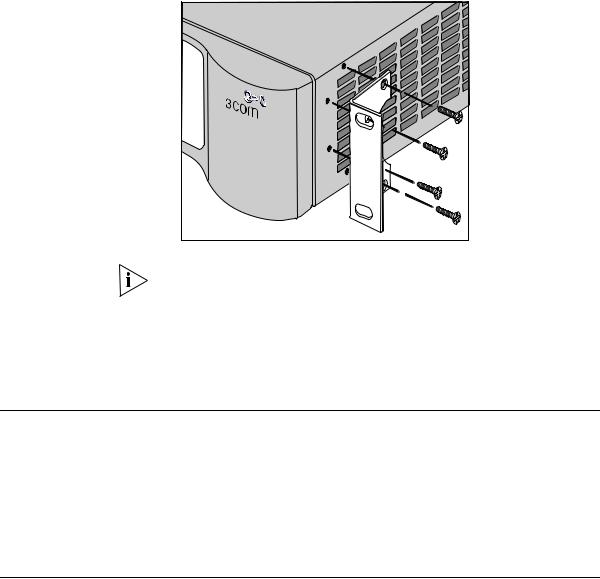
24 CHAPTER 2: INSTALLING THE SWITCH
Figure 4 Fitting a bracket for rack-mounting
You must use the screws supplied with the securing brackets. Damage caused to the unit by using incorrect screws invalidates your warranty.
4Repeat steps 2 and 3 for the other side of the Switch.
5Insert the Switch into the 19-inch rack and secure with suitable screws (not provided). Ensure that ventilation holes are not obstructed.
6Connect network cabling.
Placing Units On If the Switch units are free-standing, up to four units can be placed one Top of Each Other on top of the other. If you are mixing a variety of Switch and Hub units,
the smaller units must be positioned at the top.
If you are placing Switch units one on top of the other, you must use the self-adhesive rubber pads supplied. Apply the pads to the underside of each Switch, sticking one in the marked area at each corner. Place the Switch units on top of each other.
Creating an XRN 3Com Switch 4050/4060 units and the Switch 4900 Series units can be Distributed Fabric interconnected to create an XRN Distributed Fabric and then treated as a
single manageable unit with one IP address. A combination of any two of these units is allowed to be interconnected.
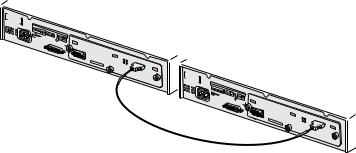
Creating an XRN Distributed Fabric 25
How To Interconnect To interconnect any two Switch 4900 Series or Switch 4050/4060 units Units you will need to order the XRN Interconnect Module Kit (3C17715). The kit consists of two XRN Interconnect Modules and an Interconnect Cable.
Both Switches must have an unused expansion slot to allow an Interconnect Module to be fitted.
Figure 5 Interconnecting two Switch 4900 units
Rules For
Interconnecting Units
90 |
VS-UPPLY DATA |
|
|
|
- 240 |
Hz |
A |
I |
|
INPUT |
|
V |
A |
27 |
12Max |
(max)Console |
|
19200,8,1,N |
S/N: |
|
XXXX/7XXXXXXXXX |
Unit 1 |
|
U |
Activity |
nit 2 |
|
|
Status |
XRN |
|
|
Interconnect |
Module |
|
|
|
(3C17716) |
90 |
VS-UPPLY DATA |
|
|
|
- 240 |
Hz |
A |
I |
|
INPUT |
|
V |
A |
27 |
12Max |
(max)Console |
|
19200,8,1,N |
S/N: |
|
XXXX/7XXXXXXXXX |
Unit 1 |
|
U |
Activity |
nit 2 |
|
|
Status |
XRN |
|
|
Interconnect |
Module |
|
|
|
(3C17716) |
For information on ordering the XRN Interconnect Kits contact your supplier. For illustrations and information on how to install the XRN Interconnect Kits, refer to the user documentation that accompanies these Kits.
This information is also provided in the user documentation that accompanies the XRN Interconnect Kits.
■The maximum number of Switch units that can be interconnected is two.
■XRN Interconnect Modules are NOT hot-swappable or hot-insertable. Ensure that the Switch is powered off before inserting or removing an Interconnect Module.
■Only 3Com XRN Interconnect Cables can be used to connect two Interconnect Modules.
■It is not possible to interconnect the Switch 4900 Series and Switch 4050/4060 units with any other 3Com device.
■3Com strongly recommends that you upgrade all Switches to be interconnected to the latest software agent.
■3Com recommends that you initialize a Switch unit that has previously been used elsewhere in your network before you interconnect to an
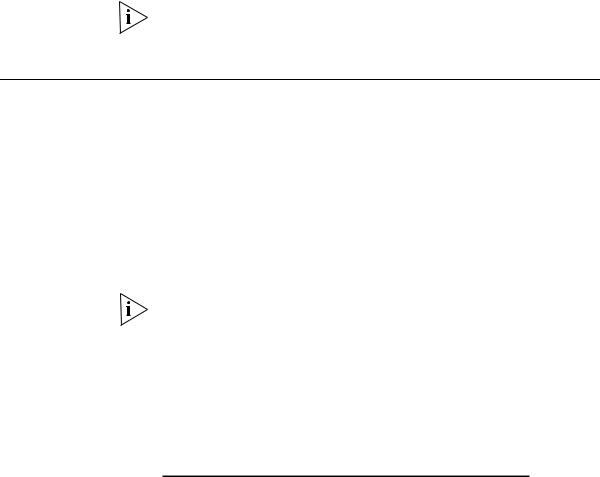
26 CHAPTER 2: INSTALLING THE SWITCH
existing unit. If you do not initialize the unit, problems may be caused by conflicting Switch configurations.
■When the Switch units are interconnected they are assigned a unit number dependent on which XRN Interconnect Cable end is connected to which Switch. That is, the Switch with the blue cable end will be assigned the identity of Unit 1 and the Switch with the yellow cable end will be assigned the identity of Unit 2.
For a detailed description of how XRN Technology operates and implementation guidelines, please refer to the Implementation Guide on the CD-ROM that accompanies your Switch or on the 3Com Web site.
The Power-up |
The following sections describe how to get your 3Com Switch 4050 and |
Sequence |
4060 powered-up and ready for operation. |
Powering-up the Use the following sequence of steps to power-up the Switch.
3Com Switch 4050 and 4060
1Plug the power cord into the power socket at the rear of the Switch.
2Plug the other end of the power cord into your power outlet.
The Switch powers-up and runs through its Power On Self Test (POST), which takes approximately 10 seconds.
Repeat for the second power supply if it is fitted.
Checking for Correct During the Power On Self Test, all ports on the Switch are disabled and Operation of LEDs the LEDs light in a rapid sequence.
When the POST has completed, check the Unit Status to make sure that your Switch is operating correctly. Table 6 shows possible colors for the LED.
Table 6 Unit Status Colors
Color |
State |
|
|
Green |
The Switch is powered-up and operating normally. |
Yellow |
The Switch has failed its Power On Self Test (POST). |
Off |
The Switch is not receiving power. |
|
|
